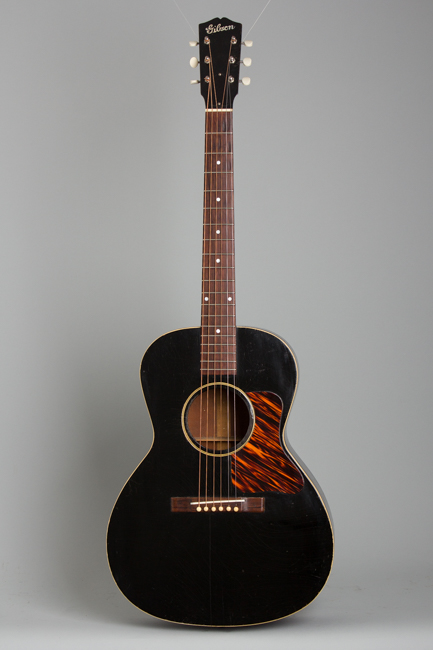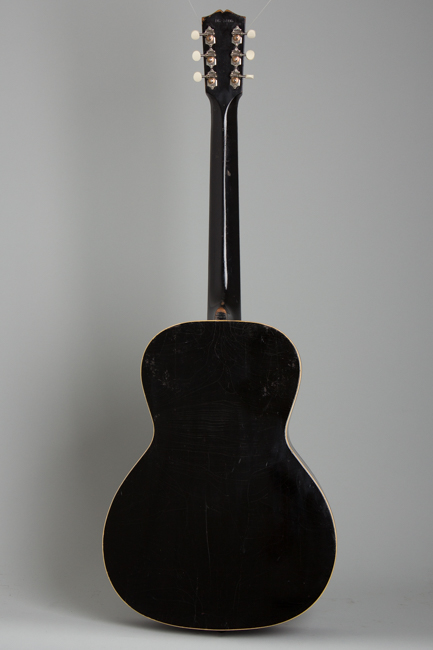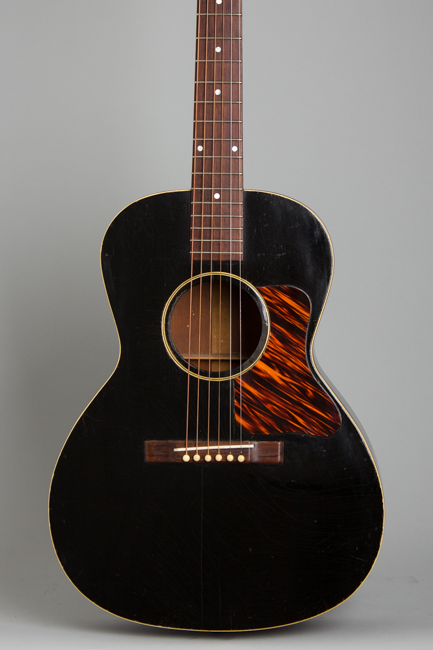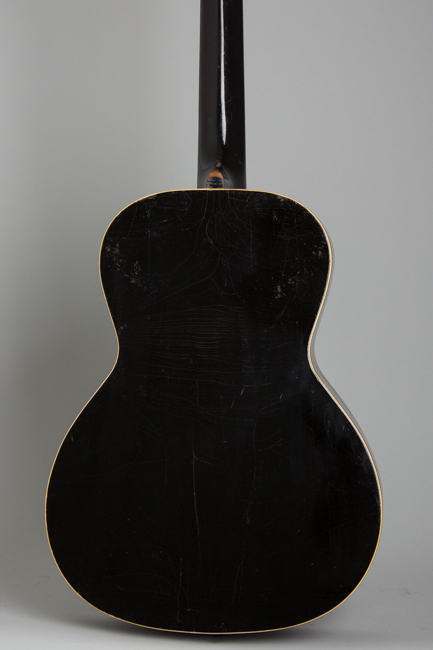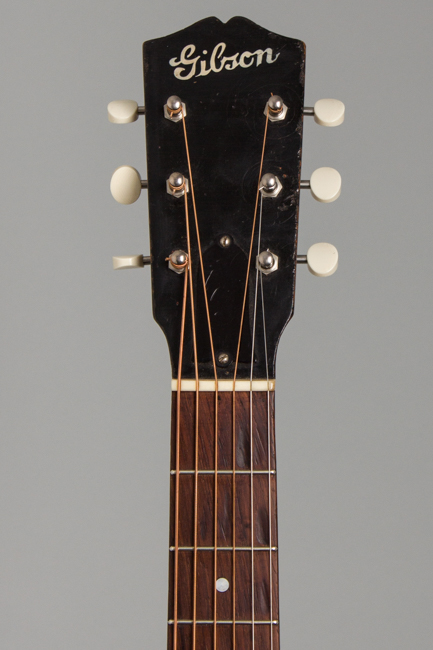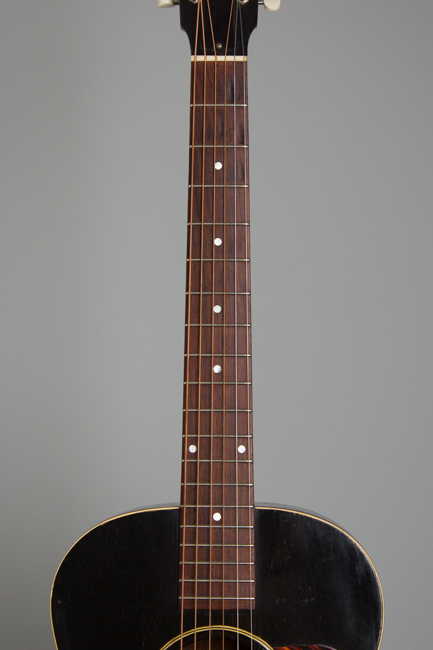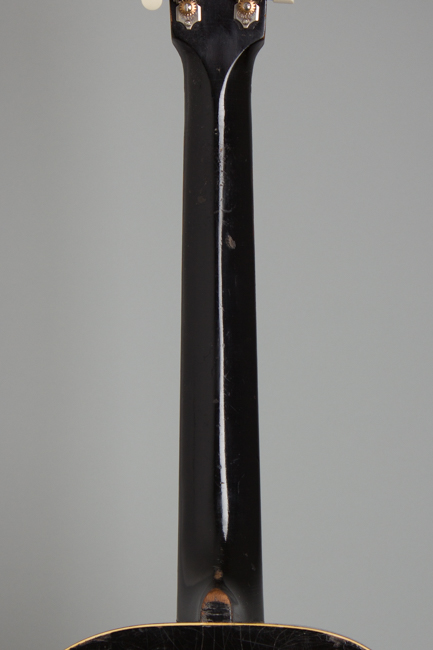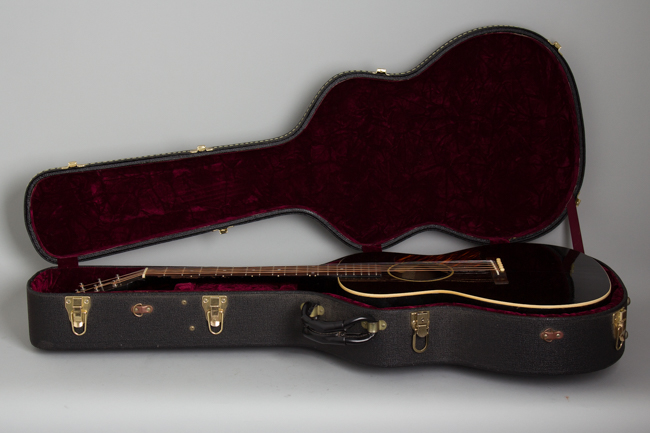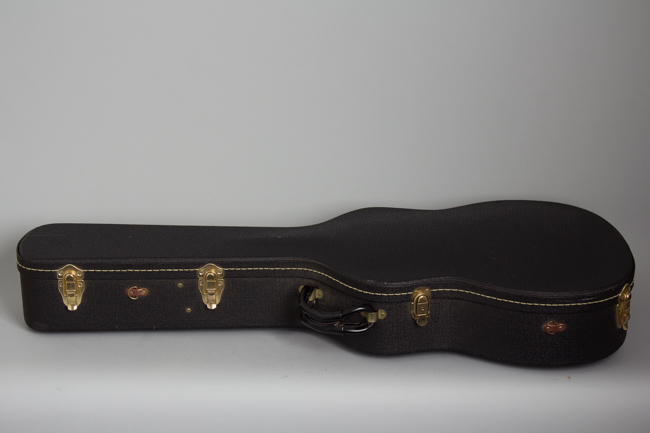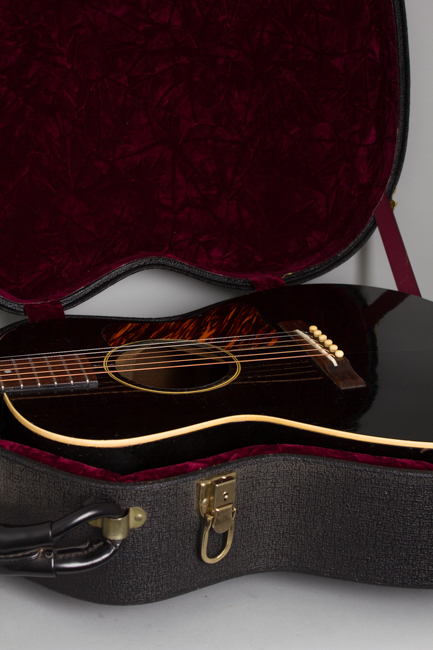Gibson L-0 Flat Top Acoustic Guitar (1938)
This item has been sold.
Item # 11001
Prices subject to change without notice.
Gibson L-0 Model Flat Top Acoustic Guitar (1938), made in Kalamazoo, Michigan, serial # DG-5106, black lacquer finish, mahogany back, sides and neck, spruce top, rosewood fingerboard, black tolex hard shell case.
The L-0 and L-00 sister guitars have generally been Gibson's most popular Depression era flat tops, then and now. These two models are often confused with each other; sometimes it seems even Gibson was not always sure which was which! The L-0 was originally discontinued in the early 1930s in favor of the L-00, but the model name was revived in 1938 as this ebony-finished guitar, now a step under the sunburst-top L-00 which, earlier in the decade, it had been ranked above. Welcome to the fun world of pre-war Gibson cataloging!
When it re-appeared in 1937 the L-0 was now at the bottom of the flat-top line at the rock-bottom price of $25 (plus case). "A Genuine Gibson at $25" trumpeted the catalog. It offered a great value in sound and playability, essentially the same instrument as the now-$30 L-00 but with the more forgiving solid ebony finish overall. This example was built in 1938 and has an early example of the stamped FON (factory order number) on the back of the headstock.
The finish is solid black overall, the trademark of the 1937-42 L-0. There is single-ply white celluloid binding around the body edges and a simple 3-ply soundhole ring. The top is also ornamented with a "firestripe" tortoise celluloid pickguard. The neck has a fairly shallow "V" profile neck with an unbound, dot inlaid rosewood fingerboard. The headstock carries a white stenciled "Gibson" logo on the face The original rosewood bridge does not have the reinforcing bolts with their pearl dot caps.
This model was a working-class standard of the day, a professional grade guitar at a price affordable to blues players, Hillbilly string bands, and many other itinerant musicians as well as Gibson's intended student customers. Each one of these guitars has its own character and this one is great-sounding both finger- and flat-picked, with a powerful ringing tone that never gets harsh. This is a very nice example; many of these pre-war Gibson flat-tops have been heavily used and often amateurishly repaired, while this one shows only some light wear and modest repair and remains its excellent player.
Overall length is 39 5/8 in. (100.6 cm.), 14 3/4 in. (37.5 cm.) wide at lower bout, and 4 1/4 in. (10.8 cm.) in depth at side, taken at the end block. Scale length is 24 3/4 in. (629 mm.). Width of nut is 1 3/4 in. (44 mm.).
While showing some wear and repair this nearly 85 year old L-0 remains mostly original and has less evidence of heavy use than most. The finish shows typical broad checking and some general wear with dings, checks and scrapes but no large areas of loss. The only deeper wear on the face is to the soundhole rim, which has been touched up discreetly. The back has some deeper dings and scrapes but no major buckle wear. There is some wear to the back of the neck with chips and dings along the fingerboard edges and a noticeable ding in the back behind the third fret; for some reason the tip of the neck heel is heavily worn down.
There are several well-sealed grain splits to the spruce top; the longest runs from behind the bridge to the back edge, behind the A and D strings. This has been neatly glued and cleated. Another shorter crack runs off the back edge below this, with a very small split near the rear curve of the lower bass bout. Another small split runs from the treble side of the fingerboard to the soundhole rim; a thin piece of spruce was added under the forward lip of the soundhole rim to stabilize the top there. All of these are neatly repaired with no added finish work.
The back has one long grain crack near the center; this is also neatly sealed up. The bridge was re-attached cleanly, with a small spot of touch-up off the forward edge. A tiny screwhole was patched on the treble side bridge wing. Internally the thin maple bridge plate appears original, as does all the very light bracing. The neck angle is excellent; if this guitar has had the neck re-set it is an exceptionally neat job. The frets appear to be the correct original style wire but we have to assume an older re-fret as there is some noticeable divoting to the fingerboard in the first position but comparatively little fret wear. The nut appears to be a very old replacement so it is possible this work was done many decades ago.
The tuners are modern individual Grover units. There was no widening of the tuner shaft holes and original machines could be seamlessly restored if desired. This is an excellent playing guitar, featherweight with a very lively sound. We always love these "Basic Black' Gibsons and this one has a great vibe. It is housed in a nice modern HSC. Overall Excellent - Condition.
The L-0 and L-00 sister guitars have generally been Gibson's most popular Depression era flat tops, then and now. These two models are often confused with each other; sometimes it seems even Gibson was not always sure which was which! The L-0 was originally discontinued in the early 1930s in favor of the L-00, but the model name was revived in 1938 as this ebony-finished guitar, now a step under the sunburst-top L-00 which, earlier in the decade, it had been ranked above. Welcome to the fun world of pre-war Gibson cataloging!
When it re-appeared in 1937 the L-0 was now at the bottom of the flat-top line at the rock-bottom price of $25 (plus case). "A Genuine Gibson at $25" trumpeted the catalog. It offered a great value in sound and playability, essentially the same instrument as the now-$30 L-00 but with the more forgiving solid ebony finish overall. This example was built in 1938 and has an early example of the stamped FON (factory order number) on the back of the headstock.
The finish is solid black overall, the trademark of the 1937-42 L-0. There is single-ply white celluloid binding around the body edges and a simple 3-ply soundhole ring. The top is also ornamented with a "firestripe" tortoise celluloid pickguard. The neck has a fairly shallow "V" profile neck with an unbound, dot inlaid rosewood fingerboard. The headstock carries a white stenciled "Gibson" logo on the face The original rosewood bridge does not have the reinforcing bolts with their pearl dot caps.
This model was a working-class standard of the day, a professional grade guitar at a price affordable to blues players, Hillbilly string bands, and many other itinerant musicians as well as Gibson's intended student customers. Each one of these guitars has its own character and this one is great-sounding both finger- and flat-picked, with a powerful ringing tone that never gets harsh. This is a very nice example; many of these pre-war Gibson flat-tops have been heavily used and often amateurishly repaired, while this one shows only some light wear and modest repair and remains its excellent player.
Overall length is 39 5/8 in. (100.6 cm.), 14 3/4 in. (37.5 cm.) wide at lower bout, and 4 1/4 in. (10.8 cm.) in depth at side, taken at the end block. Scale length is 24 3/4 in. (629 mm.). Width of nut is 1 3/4 in. (44 mm.).
While showing some wear and repair this nearly 85 year old L-0 remains mostly original and has less evidence of heavy use than most. The finish shows typical broad checking and some general wear with dings, checks and scrapes but no large areas of loss. The only deeper wear on the face is to the soundhole rim, which has been touched up discreetly. The back has some deeper dings and scrapes but no major buckle wear. There is some wear to the back of the neck with chips and dings along the fingerboard edges and a noticeable ding in the back behind the third fret; for some reason the tip of the neck heel is heavily worn down.
There are several well-sealed grain splits to the spruce top; the longest runs from behind the bridge to the back edge, behind the A and D strings. This has been neatly glued and cleated. Another shorter crack runs off the back edge below this, with a very small split near the rear curve of the lower bass bout. Another small split runs from the treble side of the fingerboard to the soundhole rim; a thin piece of spruce was added under the forward lip of the soundhole rim to stabilize the top there. All of these are neatly repaired with no added finish work.
The back has one long grain crack near the center; this is also neatly sealed up. The bridge was re-attached cleanly, with a small spot of touch-up off the forward edge. A tiny screwhole was patched on the treble side bridge wing. Internally the thin maple bridge plate appears original, as does all the very light bracing. The neck angle is excellent; if this guitar has had the neck re-set it is an exceptionally neat job. The frets appear to be the correct original style wire but we have to assume an older re-fret as there is some noticeable divoting to the fingerboard in the first position but comparatively little fret wear. The nut appears to be a very old replacement so it is possible this work was done many decades ago.
The tuners are modern individual Grover units. There was no widening of the tuner shaft holes and original machines could be seamlessly restored if desired. This is an excellent playing guitar, featherweight with a very lively sound. We always love these "Basic Black' Gibsons and this one has a great vibe. It is housed in a nice modern HSC. Overall Excellent - Condition.
